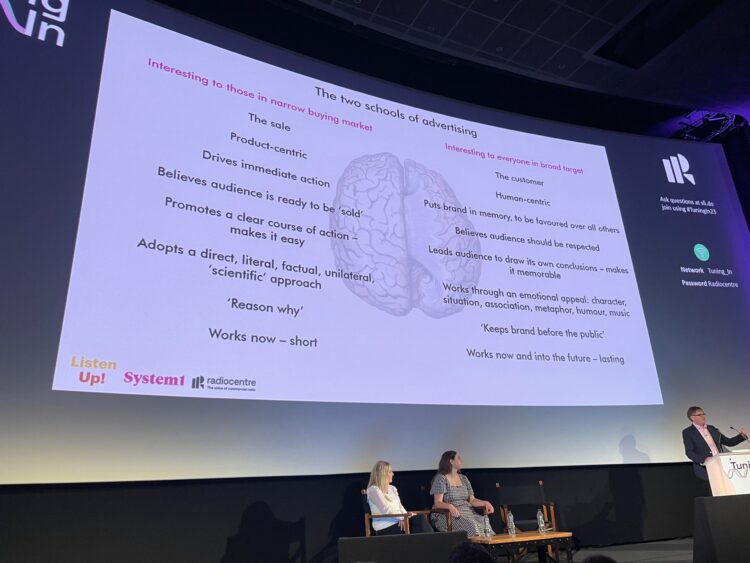Radiocentre, the industry body for commercial radio, has released new research with System1 on the emotional impact and effectiveness of audio advertising.
At today’s Tuning In conference, findings from research, entitled Listen Up!, audio advertising’s emotional resonance, effectiveness and ensuing long- and short-term results for brands were analysed.
Radio was found to be “as likely” to cause long-lasting effects through an emotional response as TV advertising, with the average score for average long-term effectiveness in System1’s database the same for both with 2.4 stars out of 5.9.
Audio ads that made listeners feel “more positive emotion” and less negative emotion triggered “significantly more consumer action change” including brand purchase and use.
Meanwhile, ads using more “right-brain” features like character, story unfolding, a sense of place and dramatic intimacy created more positive emotion, which attracted attention from broader audiences and formed stronger memories, leading to a higher likelihood of causing longer-lasting brand effects.
Consumer reactions to audio ads were measured in System1’s new Test Your Ad Audio tool and using radio effectiveness data collected by Radiocentre over 10 years. This Radiogauge data covered 55 different campaigns including 131 different radio ads across 30 different product categories, and covering a sample of 50,000 combined commercial and non-radio listeners. The tool was also billed as helping advertisers predict, understand and improve creative effectiveness of audio ads by collecting real human emotion data and brand recognition data in under 24 hours without putting their spots on air.
Audio’s ‘left- and-right brain’ first
The ads were assessed for long-term effectiveness through positive emotion (star rating), short-term effectiveness from the speed and intensity of listeners’ feelings after exposure (spike rating), and the percentage of correct brand attribution after listening to the ad once (fluency rating).
Andrew Tindall, creative and media partnership director at System 1, said this research was “the first time” left and right brain thinking had been applied to audio ads, which is normally associated with TV advertising, and isolated creative audio features for each like commanded actions, data and figures, and technical language, compared to characters with vitality, stories unfolding and music with discernible melodies.
He explained: “Right brain features attract out broad attention, create more positive emotion and more longer lasting memory structures, as opposed to left brain features which attract less broad attention, less positive emotions and form less long term memory structures. That’s why these features are better for message driven short-term focused radio ads.”
Trust-building power
The “most powerful finding” from the research, Tindall added, was that radio campaigns that did not create much positive emotion prompted “limited change” in consumer behaviour.
Tindall said: “It’s very clear. If advertisers want to change behaviour towards their brand, they need to use audio ads that elicit strong positive emotions.”
The research uncovered “a very clear, significant positive relationship” between long-term effectiveness of radio campaigns and positive emotion, ad brands using audio advertising should use more right-brain features than left brain features if advertising for long-term effects. Tindall highlighted in System 1’s database the average “star rating” for TV and radio ads were very similar, so it was expected they would have “very similar long-term effects”.
He also said advertisers wanting to build on trust should use radio advertising with “distinctively famous audio brand assets to truly take advantage of the trust-building power of radio”.

Orlando Wood, chief innovation officer at System 1, chaired a panel (pictured, above) at Tuning In with Claire Bryant, marketing manager for broadcast campaigns at Specsavers, and Georgiana Berndhart, brand marketing manager at Moonpig.
Wood said: “There are very different styles of advertising protect for two different types of attention. Radio can do both brilliantly. It’s the one on the right [brain] though that is more important for long-lasting and broad effects.”
Bryant and Berndhart both said their brands used radio as part of multimedia campaigns, however, Berndhart had tried using radio without AV “for the first time in a really long time” in August.
She said they used a mix of linear radio and more and more digital, and that the radio ads worked “really well” as a “standalone asset”.
Mark Barber, planning director at Radiocentre, said: “In demonstrating how well-executed audio-only advertising can be as powerful as audio-visual advertising and the importance of using more emotional right-brain creative features in optimising its effect, System1’s data-driven interrogation of audio creativity has the potential to transform attitudes towards audio advertising in general.”
Editor’s note (4.30pm): This story was edited after publication to include more quotes and a picture from today’s Tuning In event.
Adwanted UK are the audio experts operating at the centre of audio trading, distribution and analytic processing. Contact us for
more information on J-ET, Audiotrack or our RAJAR data engine. To access our audio industry directory, visit
audioscape.info and to find your new job in audio visit
The Media Leader Jobs, a dedicated marketplace for media, advertising and adtech roles.






